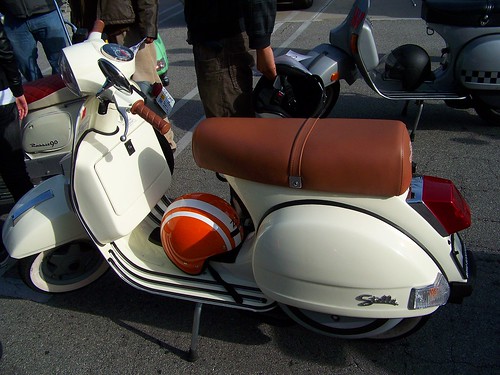
Before the chrome kit was added. By my pal snapshot05, on Flickr
Intro
There have been few scooters to debut in the US carrying as much baggage as the Genuine Stella 4T (4-stroke). It comes preloaded with the stigma of being a 4T shifter and common perceptions of the Bajaj 4Ts as slow vehicles with a variety of quality issues. It's got a lineage that can be traced to Vespa but, as many people will complain, it's not a Vespa and it's built in India. As enthusiastic as some people are about the long-awaited arrival of a 50-state version of the Stella, others question whether there is a need or demand for such a thing. Others pre-judged the scooter long before even seeing it in person.
On top of all that, delivery was delayed by a year due to the Stellas being singled out for additional inspections by Customs and the EPA (despite having already been approved for sale). During this time, there was all sorts of theorizing, rumor mongering and conjecture about Genuine and the state of the scooters. The conclusion? The EPA didn't like a ball of glue and the adhesive used for a label.
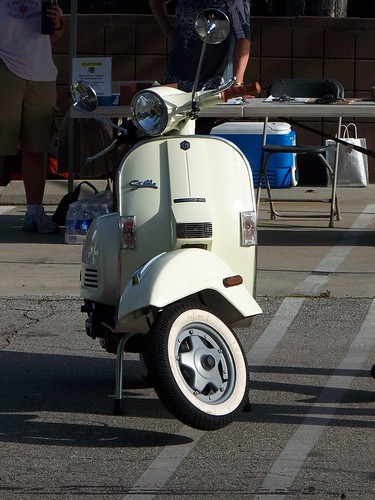
By snapshot05, on Flickr
At the center of all of this, the humble Stella 4T. Its roots are the Vespa P-series, the most utilitarian and (arguably) least graceful of the company's models. It's the workhorse of the stable. From the mid-'80s through the '90s, LML, the company that builds the Stella, manufactured Vespa PXs and LML variants (the NV and Select models) under an agreement for Piaggio/Vespa. The two companies ended their relationship in 1999, but LML was allowed to continue building its own versions of the PX, which became the Star. Genuine Scooter Co. began selling a rebranded version of the Star as the Stella in the US in 2003.
The Star/Stella 4T is the result of years of collaboration between Genuine and LML. The original Stella was never sold in California, the country's largest scooter market, due to state emissions standards. Similarly, emissions controls have been tightening in Europe and Asia, and the 2-stroke version eventually would have been regulated out of existence. The new 4T engine reduces emissions, but also alters performance and necessitated some design changes. It's a whole new Stella, but also sort of not.
Comparisons to the Stella 2T are understandable. Comparisons to the Vespa PX, inevitable. But as much as it resembles these models, the Stella 4T deserves to be judged on its own before the comparisons come pouring in. I've got just over 3,000 miles on my Stella 4T now, more than enough to give it a fair shake.
A few caveats and notes:
Prior to the Stella 4T, my daily rider was a Vespa LX 150 with a lot of performance modifications including a 191cc kit, performance variator, sliders, exhaust. I also own a Buddy 125, have spent a good amount of time riding Buddy 150s and have test ridden many other scoots. I'm 5' 10" and around 230lbs.
Full disclosure: I got the scoot through an arrangement with my dealer and Genuine. It was used as a demo model and I got it semi-used for less than MSRP, 250 miles on the odometer. It had a couple cosmetic "blemishes" from having been lightly dropped a couple times and had been sat on by a couple hundred people, all of whom made "vroom vroom" noises while cranking the shifter. Slightly used, whatever; I was happy to have it. I took possession when the original Stella 4T shipment arrived in the US. No one thought it would be a year (rather than weeks) before they arrived at dealers. Neither Genuine nor my dealer has asked me to review the scooter or in any way influenced this review. These are my honest, uninfluenced perceptions and opinions.
The Specs
Engine: 147.55cc 4-Stroke, Air Cooled
Transmission: 4-speed manual with "twist grip" shifting
Colors: Avocado, Creme, Slate Blue, White, Dijon Yellow, Red
Suspension: Gabriel® performance shocks
Tire Size: 3.5" x 10" Interchangable
Braking: Front Grimeca Hydraulic Disc, 6" Rear Drum
Top Speed: 60+ mph
MPG: 140 (EPA city estimate)
Warranty: 2-Year / Unlimited-mile
M.S.R.P.: $3,599 (MSRP does not reflect destination or other dealer vehicle preparation charges.)
You can see the other colors on Genuine's official Stella 4T page.
What's the difference between a four-stroke (4T) and a two-stroke (2T)? I try to explain it here.
The Lowdown
For those looking to get the basic scoop on the Stella without my ruminations, here are answers to most common and probable questions. I'll go into some of it in more detail later.
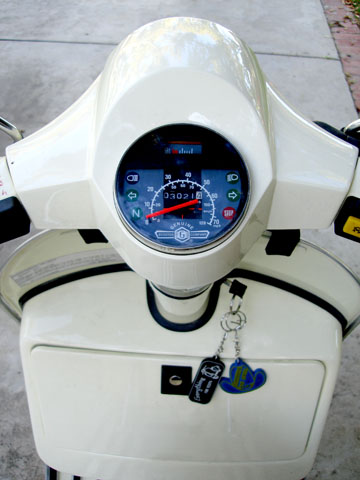
• For better or worse, it's very much not a "modern scooter" that shifts. In terms of riding and operation, there are few differences from the Stella 2T or a Vespa P.
• Yes, it's EPA rated at 140 MPG. I don't keep consistent track of my mileage but average around 100 MPG when I have. It's been a little higher in the summer, lower in winter. This may be due to warm up, revving the engine or California's different summer and winter fuel mixtures. Time will tell.
• It tops out around 60mph. 55mph reliably, no problem. 65mph downhill. With everything stock, it won't go over 65mph. No, it's not good for freeway travel, even if legal in your state.
• No major issues so far. When I took it, the clutch cables were stretched out and all out of adjustment from the aforementioned cranking of the shifter. I also needed the clutch worked on at about 1200 miles (IIRC); the plates were replaced. My technician has told me this was likely due to early riders abusing it, throttle abuse and so on. While I know the ins and outs of a CVT, I'm less familiar with the manual clutch and so can' provide much detail on this.
• Biggest positives: Faster than I thought it'd be, especially after break in. Handles great; no pulling to the side, very well-balanced.
• Biggest negatives: Didn't like stock whitewalls. They may work for some riders, but I swapped them for Michelin S1s after several months. Loud turn signal clicker. Evap system (more on this below).
On the Outside
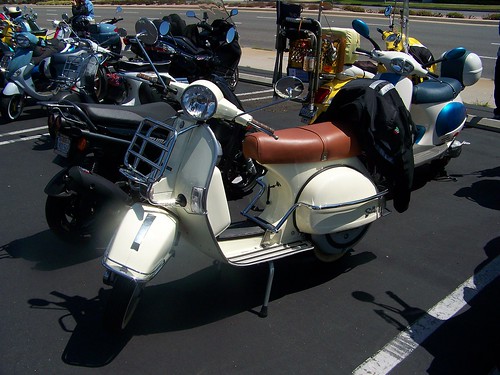
With the chrome kit. By snapshot05, on Flickr
In terms of its physical appearance, the Stella 4T is nearly identical to its 2T predecessor. The form is inherited from its classic Vespa P-series ancestor: squarish legshield and horncast, hefty cowls. The most easily-spotted differences from the earlier Stellas are the louvers in the right cowl and the star-shaped wheel hubs. The seat and rear cowls are a touch longer, but will still work with most accessories (with a little modification). I have the complete Vespa PX chrome kit on mine and all it required was a couple of notches under the upholstery of the seat's bottom. No one would notice with the seat closed.

A harder to spot difference is the two-piece chassis. This is a big departure from the 2T, an accommodation for the new engine and providing access to it. You have to look pretty hard to notice that the "monocoque" frame is now a "duocoque" with a tubular frame at the rear. It's completely unnoticeable while riding.
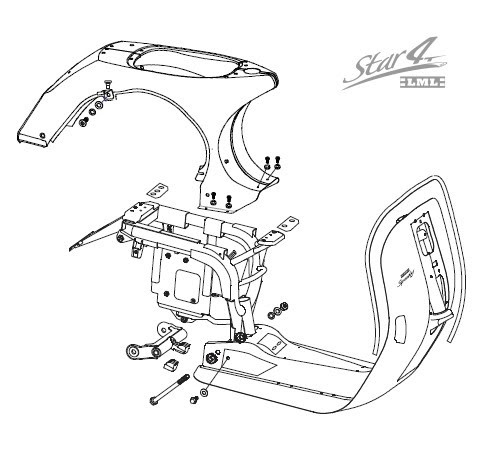
I haven't separated mine yet, but may in the next week or so. Pics will follow.
Though the Stellas lack underseat storage, the glovebox is very roomy. I can fit as much stuff in there as in my LX's pet carrier.
Fit and finish on the Stella 4T are good; arguably better than the 2Ts but that may just be people expressing color preferences. In general, what you see will be on the same level as the Stella 2T. This isn't the super-slick ultimate luxury scooter though. It's more of a Jeep than a Cadillac; everything is designed for function.
Operation
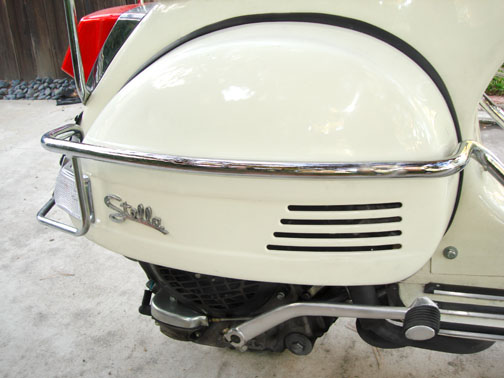
Kickstarts easily, first kick almost every time!
The Stella 4T features both an electronic ignition and a kickstarter. It has a manual choke and a fuel petcock to turn the gas feed off, on or switch to the auxiliary tank. For those transitioning from an automatic scooter, the turn signals are on the right grip. (This takes some getting used to.) So, yeah, it works just like the 2T, right down to some of its idiosyncrasies. The fuel gauge is fairly inaccurate; I just haven't calculated how much yet.
The Stella starts up pretty easily. It's warm-blooded though, and takes several minutes to warm up after a cold night. I never had any problems with this in the warm months, and think I may have just needed to adjust the idle a bit.
Shifting
I came to the Stella as a first time shifter rider. I'd ridden some MCs recreationally, and a Vespa small frame, once, over a decade ago. So as far as it goes, a total newbie. The info here is oriented to fellow new/never shifters but may be of use to others.
Like most shifting scooters, the Stella has a clutch lever on the left and the left grip rotates to shift gears. The rear brake is engaged using a pedal on the floorboard. There's no tachometer; you know to shift by sound, feel, speed and instinct.
My first impression getting on the Stella 4T: plenty of low-end torque. Enough to pull a really big wheelie my first time on it. Somehow, all my knowledge and experience from shifting cars went out the window in that moment, as in "don't hit the gas then just get off the clutch; ease into gear." Aside from that and some early bumps and issues, within weeks I was hauling around town like shifting was second nature. I still get stuck between gears on occasion and am always developing the finer skills of shifting. For the most part it's not as bad as many new riders seem to fear.
Some riders say shifting provides more control than riding an automatic. I'm not sure I'd completely espouse that view, as there are subtleties to mastering throttle control on an auto. It does, however, provide another dimension to the human/machine interface, that bond between rider, scooter and the road. Both shifters and automatics have their benefits, but the Stella 4T has become my daily commuter (lots of shifting) while my Vespa is reserved for longer or faster rides. While I now appreciate how well CVTs are designed and work, there's a visceral thrill to shifting—running up the RPMs and banging into gear—that you don't get from an auto.
A few downsides to shifting: It definitely takes more work to shift and requires a degree of attention not needed when riding an automatic. More than when driving a manual car, even, I'd say. On long rides with a lot of curves and hills (i.e., constant shifting) it can wear you out a bit. Also, it's a bit more physically demanding and I had to switch from using a messenger bag to a backpack because I my back and shoulder were aching. I carry a heavy load, but it's fine with a backpack now. For those with carpal tunnel or chronic back issues, a shifter may not be the best way to go.
Performance
The first reaction many scooterists with any knowledge of past models will have to a 4T shifter: "It's going to be slow. Bajaj 4Ts were slow." Yeah, maybe, but that's kind of like saying "All cars with 4-cylinders are slow." Not all engines are created equal. I'd say the Stella 4T isn't slow; it's certainly faster than the Bajaj I've ridden alongside.
Acceleration and speed is one of the areas where it makes sense to compare to others. Speed is relative.
Off the line, it doesn't scream. It's closer to most stock 125s/150s than, say, a Buddy 125 which is very quick off the line. It's good enough for lane splitting and pulling away from traffic. I do find myself creeping into the crosswalk and getting ready to pull away when a light turns green more than on my other scoots. It accelerates nicely in 2nd and 3rd gears.
According to this video from UK LML distributor Eddy Bullet, the 4T actually beats both catalysed (restricted) and derestricted, rejetted 2T Stars (Stellas) off the line. Hopefully, some shops in the US will try the same for comparison.
<object width="480" height="390"><param name="movie" value="http://www.youtube.com/v/HgdlnPhWV3I?fs ... ram><param name="allowFullScreen" value="true"></param><param name="allowscriptaccess" value="always"></param><embed src="http://www.youtube.com/v/HgdlnPhWV3I?fs ... n_US&rel=0" type="application/x-shockwave-flash" allowscriptaccess="always" allowfullscreen="true" width="480" height="390"></embed></object>
My top speeds are anywhere from just over 60mph on flats to 65mph downhill. Like a lot of shifters, acceleration degrades on steep hills. Depending on grade and length of the hill, I'll get down to 40mph-55mph. (These are speedometer-indicated, not GPS-verified speeds.)
What is surprising is how well the Stella 4T fares compared to many of the vintage shifters that I've ridden alongside at group rides. The Stella ably keeps up with all, and is as fast as most with the exception of the 200cc Vespas. It's faster (in top speed and acceleration) than a friend's VB with a P200 engine. It flew by a fellow rider who just rebuilt a P150. He was slightly gobsmacked and jealous. All those vintage faithful prematurely complaining about the Stella 4T's performance may have some newfound respect for them once they ride next to one. Or they'll just hate it because it doesn't sound and smell like a 2T.
A dealer who had a number of riders try the Stella 2T before test riding the 4T told me that many preferred riding the 4T by the end of the test.
Once the engine's broken in, the performance only gets better. While there was little-to-no gain in top speed, the acceleration improved and the engine took on a slightly deeper rumble. It's still pretty dang quiet while idling—more than my other 4T scoots. When I first started riding, I had to tweak the throttle at lights occasionally to make sure it was still running.
Performance Parts
There aren't a lot of performance parts available for the Stella 4T at this moment but it's only a matter of time before we start seeing more. Polini has a pipe and a 165cc cylinder kit coming out. A Pinasco pipe is currently available.
Handling, Braking
Overall, the Stella handles quite smoothly. It's agile in turns and curves. It feels light and nimble. It doesn't pull to either side. Compared to a Buddy, the Stella feels a bit more balanced, with a higher center of gravity. Riding it up in the twists and turns of the area hills and canyons provided me with a better understanding of why this form has endured for so long. It's not just aesthetics or nostalgia; it works.
The lean angles aren't as good as on some modern scooters, particularly those with taller wheels. The Stella's somewhat more likely to scrape bottom on a very tight/fast curve but doesn't have a protruding center stand or exhaust like most modern scoots. In general, it's very capable, but required some adjustment in riding style.
As mentioned above, I wasn't keen on the Sava whitewalls that came stock on my Stella. Even properly inflated, they felt a bit squishy, a little slippery. (Keep in mind, though, that I'm a very aggressive and demanding rider and I'm accustomed to the high-performance racing style tires on my Vespa LX.) For whitewalls, I think the Maxxis tires (stock on Buddy 150s) are somewhat better. I eventually swapped to Michelin S1 blackwalls before the Savas expired, partially just to gauge the difference. While not dramatic, I find them to be "stickier" and grip better than the Savas and perform much better on wet surfaces.
The Stella's brakes aren't spectacular but they're adequate. As with most scooters, most stopping power is in the front brake and the front disc is comparable to stock discs on most other scoots. The rear drum brake is a bit softer. The pedal on the floorboard doesn't have the degree of control that a brake lever does. Hard stops are not as fast on the Stella as on most modern scoots. I've learned to give myself a bit more braking room and distance between myself and other vehicles.
The Dreaded Evap System
Like all scooters intended for sale in the state of California, the Stella has a mandated evap system, intended to reduce emissions by recovering and recycling vapors. This system is problematic for many scooters and motorcycles. When you buy a modern Vespa, the first piece of advice you often get is to disconnect the evap hose, as it causes rough idling, starting issues and stalling. So, Stella 4T buyers outside California, my first piece of advice is this: Disable the evap system. California's Byzantine mandates simply don't work with most scooter and gas tank designs. The effect on emissions will be negligible, especially on the already very clean Stella.
For those of you in California, disabling the evap system is illegal. Although the odds of getting caught are almost nonexistent, it would be irresponsible of me to suggest you take this action to prevent (for example) gas splashing into the hose and causing a vacuum/vapor lock stall.
UPDATE, 3/28/11: Happy to report that there are many Stella 4Ts on the road now and there have been no reports of evap system issues so far! So, for now, I say: Don't mess with it.
The Reliability Thing
I frequently read or hear people saying, "If you want a Stella, great, but it won't be as reliable as a modern auto." This is one of those oft-repeated lines that may have a smidgeon of truth, but is probably exaggerated. What is true is that the Stella 4T requires different maintenance and more frequent adjustments. The cables need tightening every couple thousand miles.
Buying Advice

With chrome and Prima roll bag
The Stella 4T should appeal to a diverse selection of buyers, but it's not the right scoot for everyone (no scooter is). These are just a few things to help guide you if you're considering buying one. That said, you could be on the "probably not for you" side of the criteria, get a Stella, and fall in love with it. There's no accounting for the je ne sais quoi factor and sometimes a scooter can work its magic on you despite all reason.
Many potential buyers may wonder if the Stella 4T will make a good first scooter. Their primary concern will likely be shifting. All I can say is this: For 50 years, the large majority of people who learned to ride scooters did so on shifters like the Stella. Take the MSF Basic Rider Course. Get a dealer or friend to teach you how to shift and give you a few lessons. Be patient and practice. Five decades of scooterists were no more predisposed to riding than you are.
The Stella may be right for you if…
• You want a vintage-style shifter with the support of a warranty and reliability of a new scooter
• You really dig the style
• You're looking for a unique or different riding experience from automatic scooters or other PTWs
• You're looking for a high-MPG, low emissions vehicle
The Stella may not be right for you if…
• You need a freeway-capable scooter or something that will go over 60mph
• You're not physically up to the task of shifting
• What you really want is a modern scooter with all its accoutrements, but you want one that shifts




